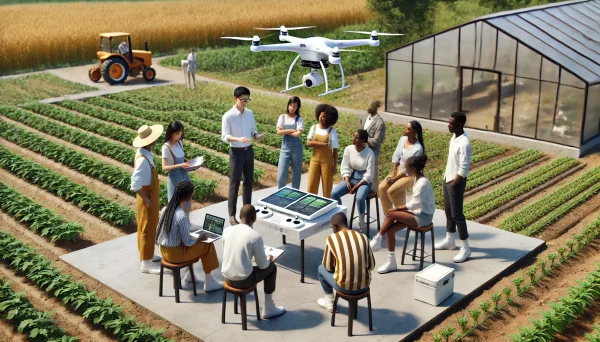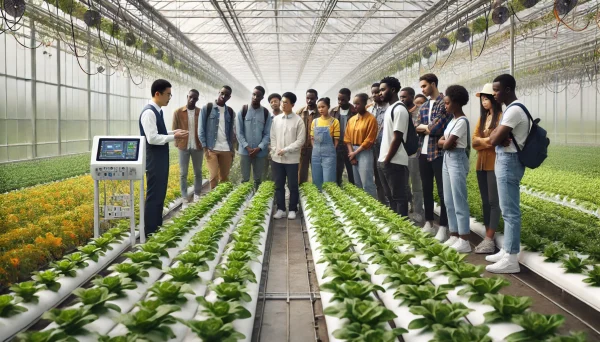China Receives Republic of Congo Students for Smart Agriculture Training Program Introduction
I. Background of the project
1. Potential for agricultural cooperation between China and Republic of Congo
Republic of Congo is a resource-rich country in west-central Africa, and agriculture is an important pillar of the country’s economy. However, for a long time, agricultural production in Republic of Congo is still dominated by the traditional mode, with low level of agricultural technology and low production efficiency. Despite the country’s very favorable natural resource conditions, the agricultural industry faces multiple challenges such as climate change, weak infrastructure and backward technology. Therefore, improving agricultural production technology, especially with the help of smart agricultural technology, has become an important way to promote the agricultural development of Republic of Congo.
China has been accumulating technological innovation and application in the field of agriculture for decades and has made remarkable achievements in many fields. China has not only made a large number of technological advances in traditional agricultural production, but has also been at the forefront of the world in intelligent agriculture, agricultural informatization, and intelligent transformation of agricultural machinery and equipment. The support of the Chinese government and related institutions has enabled China to accumulate a great deal of experience in agricultural modernization.
2. Definition and Meaning of Smart Agriculture
Smart Agriculture (Smart Agriculture) refers to the realization of the intelligence, precision and automation of agricultural production through advanced scientific and technological means, such as the Internet of Things (IoT), big data analysis, cloud computing, artificial intelligence (AI), and robotics, in all aspects of agricultural production. The implementation of smart agriculture can significantly improve the efficiency of agricultural production, reduce resource waste, increase crop yields, and cope with uncertain climate change and ecological pressures.
In Republic of Congo, the application of smart agriculture is promising, especially in enhancing agricultural productivity, strengthening the quality and safety management of agricultural products, and promoting the harmonious development of agriculture and the environment. By training international students in Republic of Congo, China can help the country’s agricultural industry achieve leapfrog development and promote agricultural modernization and sustainable development.

II. Objectives and content of the smart agriculture training program
1. Training Objectives
The main objectives of the Smart Agriculture Training Program for China to receive international students from Republic of Congo are:
– Improve technology: help Republic of Congo students master the latest agricultural technology, especially smart agriculture technology, and enhance their agricultural production capacity.
– Promote the modernization of agriculture: Through technical training, help Republic of Congo modernize its agricultural sector and improve agricultural productivity and crop yield.
– Promote cooperation between China and Republic of Congo: Promote in-depth cooperation between China and Republic of Congo in the field of agriculture through training technical talents in the field of agriculture, and promote the introduction and application of agricultural science and technology in Republic of Congo.
– Cultivate professional talents: through the training, cultivate a group of high-quality talents who know modern agricultural technology and can solve the agricultural problems in Republic of Congo, and promote the transformation and upgrading of the local agricultural production mode.
2. Training contents
Smart agriculture training courses usually cover the following main modules:
(1) Basics and Development Trends of Smart Agriculture
This module introduces the basic concepts of smart agriculture, its development history, technological development trends and the latest developments in smart agriculture around the world. Through this module, participants can understand the overall framework of smart agriculture and its important position in global agricultural modernization.
(2) Internet of Things and Big Data Technology in Agriculture
Internet of Things (IoT) is an important part of smart agriculture, which collects real-time data such as soil moisture, climate change and crop growth through sensors, drones, smart devices and other hardware, and optimizes agricultural production decisions through big data analysis. Participants will learn how to build an agricultural IoT system, how to collect and analyze agricultural data, and how to guide agricultural production through data.
(3) Precision Agriculture Technology
Precision agriculture refers to the precise management of land, crops and production environment through accurate agricultural data collection and analysis. Participants will learn how to use GPS technology, drones, sensors, and other tools to precisely manage farmland, improve land use efficiency, reduce resource waste, and improve crop yield and quality.
(4) Intelligent Agricultural Machinery and Automated Production
Intelligent agricultural machinery (e.g. intelligent seeders, driverless tractors, automatic harvesters, etc.) plays a crucial role in agricultural production. Through this module, participants will master how to use and maintain intelligent agricultural equipment and how to improve agricultural production efficiency and reduce labor costs through automated production means.
(5) Intelligent Greenhouse and Vertical Agriculture
Smart greenhouses use automated systems to regulate environmental conditions such as temperature, humidity, and light to maximize crop growth. Participants will learn how to design and manage smart greenhouses and how to achieve efficient cultivation in a vertical farming environment, adapting to agricultural production methods in the context of urbanization.
(6) Agricultural Robotics and Unmanned Technology
Agricultural robots (e.g. seeding robots, weeding robots, spraying robots, etc.) are increasingly used in agriculture. This module will help participants understand and master the working principles, technical characteristics and use techniques of agricultural robots, as well as how to use robotics to replace traditional manual labor and improve the automation level of agricultural production.
(7) Climate-Smart Agriculture and Sustainable Development
Climate change poses great challenges to agricultural production. By learning climate-smart agriculture technology, participants will understand how to improve the adaptability and risk resistance of agriculture by optimizing agricultural production methods. The course also covers the sustainable management of agro-ecosystems, such as the application of concepts of soil and water conservation, circular agriculture and green agriculture.
(8) Agricultural Finance and Policy Support
Agricultural financial services, insurance and policy support are important safeguards for the implementation of smart agriculture. Through this module, participants will learn how to enhance the income level of farmers and promote the sustainable development of smart agriculture programs through agricultural financial instruments and policy support.

III. Training Methods and Learning Environment
1. Training methods
The smart agriculture training program adopts various forms of teaching methods, including:
– Combination of theoretical courses and practical operations: Theoretical teaching helps students master the basic concepts and technologies of smart agriculture, while practical courses help students consolidate their theoretical knowledge and improve their practical operation ability through field operations and case studies.
– Combination of school-enterprise cooperation and industry-academia-research: In cooperation with China’s agricultural science and technology enterprises, students have the opportunity to get in touch with the most cutting-edge agricultural technology and participate in real agricultural projects during the training period.
– On-site teaching and simulation training: By visiting modern agricultural production bases and intelligent farms, students will have a more intuitive understanding of the application scenarios of smart agricultural technology.
2. Learning environment
The training usually takes place in Chinese agricultural universities, research institutes or training bases cooperating with enterprises, which have advanced teaching facilities and modern agricultural technology equipment. Trainees can not only get in touch with the latest agricultural technology, but also communicate with Chinese agricultural experts and scholars to obtain the latest technical information.
IV. Application Process and Tuition
1. Requirements for enrollment
– Be at least 18 years old and possess high school education or above;
– Have a certain background or foundation in agriculture and a strong interest in agricultural modernization and smart agriculture;
– Be physically fit and able to adapt to physical activities and long-term study during the training;
– Be able to understand and participate in the training program with a certain level of English or French.
2. Application process
– Submission of application: Applicants are required to fill in the application form and provide valid passports, academic certificates, proof of English/French language proficiency and other documents;
– Audit and Interview: the school or training organization conducts a preliminary audit of the applicants, and those who meet the requirements will be interviewed;
– Confirmation of enrollment and payment of fees: students who pass the audit will be given a letter of acceptance, followed by payment of tuition and accommodation fees.
3. Tuition and Scholarships
Tuition fees usually vary depending on the course content, length of training and learning resources provided. In order to help trainees with limited financial means, some universities and educational institutions in China provide scholarship or bursary support to help reduce their financial burden.
V. Future Outlook
Through the implementation of the Smart Agriculture Training Program, international students from Republic of Congo will be able to learn the most cutting-edge agricultural technology, which will help modernize the country’s agricultural industry, improve the efficiency of agricultural production and promote the sustainable development of agriculture. With the deepening of cooperation between China and Congo, smart agriculture will become an important area to promote the economic development of the two countries in the future.
Smart agriculture can not only help Republic of Congo improve agricultural production, but also promote employment, increase farmers’ income, enhance food security, and ultimately promote the overall development of the country’s agricultural sector. Under the framework of agricultural cooperation between China and Congo
framework, the smart agriculture training program will build a more solid bridge for the exchange and cooperation of agricultural technology between the two countries.

